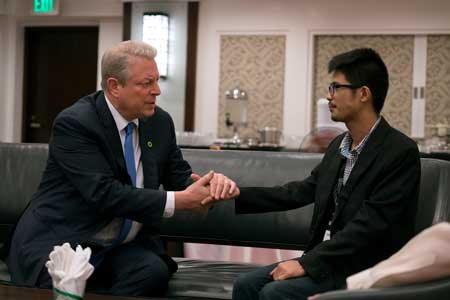Film (2017)
Directed by Jon Shenk and Bonni Cohen
Featuring Al Gore

Climate Leadership Trainee in the Philippines
and survivor of the Typhoon Haiyan
in “An Inconvenient Sequel: Truth to Power”
from PARAMOUNT PICTURES and PARTICIPANT MEDIA
Photo Credit: Jensen Walker
©2017 Paramount Pictures. All Rights Reserved.
The 2006 documentary An Inconvenient Truth publicized Al Gore’s passionate support for the recognition of global warming and broke new ground in popularizing the movement and educating people about the inherent, but not always visible, dangers associated with unrestrained carbon pollution.
The current film, An Inconvenient Sequel: Truth To Power, is a reconfirmation of that position, now put forward by filmmakers Jon Shenk and Bonni Cohen who once again feature Gore and his approach to global warming a central vehicle for presenting a treatment of the issue itself.
Al Gore is enough of a focal personality to make the core of the film interesting in a personal way. Following Gore through a series of global warming related adventures, the film generates its own species of drama. Clearly, because of the nature of this sort of documentary, the filmmakers had to find these dramas as things were unfolding rather than as a scripted preview of its subject. That somewhat off the cuff approach gives the film a spontaneous feel and a sense of its action unfolding in real time.
A lot of the drama of the film winds up focusing on the 2015 meeting in Paris about the international climate control accords and Gore’s role in helping to bring that agreement about. Much of the specific action documented in the film focuses on the question of whether India will sign the accords. As a developing nation, India felt it had constraints in ways that already developed nations did not have and hence should not be constrained by the same accords. But Gore saw that India might be persuaded to commit to using solar electrical generation on a broad scale, which would certainly tilt them in the direction of signing the climate accords.
We then see the now business-savvy and well-connected Gore on the phone with his friend Lyndon Rive, the CEO of the major American solar player SolarCity, to try to persuade him to yield some privileged intellectual property that would enable India to create more efficient solar panels. By doing so, India might be persuaded that high tech solar could and thus reduce their costs and that they could then agree to sign the Paris accords and reduce their emissions.
That is just one of the several stories that contribute to the overall narrative of the film.
The film opens with less heightened suspense but more dolorous awareness of the realities of global warming. Gore goes to Greenland to witness the collapse of various parts of the glacial masses that comprise it and to observe the dramatic changes that have occurred in the eleven years since the making of An Inconvenient Truth.
There are multiple scenes throughout showing Gore at climate awareness training sessions, sponsored by his organization internationally, and intended to raise a new generation of highly aware and informed climate educators. Some of the sweetest moments in the film involve Gore’s interaction with students from these sessions.
As well, there is the continuing reflection on Al Gore’s role as an ex-politician, or, as he calls himself, a recovering politician, who is energetic about an issue without it’s being a piece of the path to power. He is clearly one of those former politicians who does not recede into the background of his own retirement but continues actively pursue an issue about which he has been passionate since his undergraduate days.
Because of the focus on a single personality at the heart of the film, there is a bit of the here is Al doing this and there is Al doing that quality about it. Frankly, however, for those who watch and enjoy Michael Moore’s films it’s pretty much the same kind of thing except that Gore is not quite as much of an offbeat personality as Moore is. But Gore does have at times unexpected and considerable charm in front of the camera. He tells any number of funny stories in the film, one of the most hilarious of which involves a woman who passes him by in a diner, several times retracing her steps until she approaches him and says “you know, if you had dark hair you’d look just like Al Gore.”
There is an interesting subtext to the film which has more to do with politics and personality and less to do with global warming per se, even though it is that subject that serves as the vehicle for making that point about politics, passion and engagement and what people grab onto as meaningful in their public lives. It is also suggestive about what kind of enthusiasm they generate as a result. It was Bernie Sanders’ passion about social equity that lit a fire under a whole generation of young Americans in 2016 and one might well see how Al Gore could have, in a different political universe, done something similar eighteen years ago in his quest for the presidency. Here we have the example of a political leader who, after his political career, has embodied that kind of gripping vision in a way that extended beyond his political career and represents what might have, in a different time and political climate, translated into an inspiring presidency.
Filmmakers Shenk and Cohen have given voice to Gore, albeit in a kind of adulatory follow the rock star mode, but done so with a sense of craft and deft awareness of evolving narrative that might well give the film the attention that its important subject-matter deserves.
– BADMan
Leave a Reply